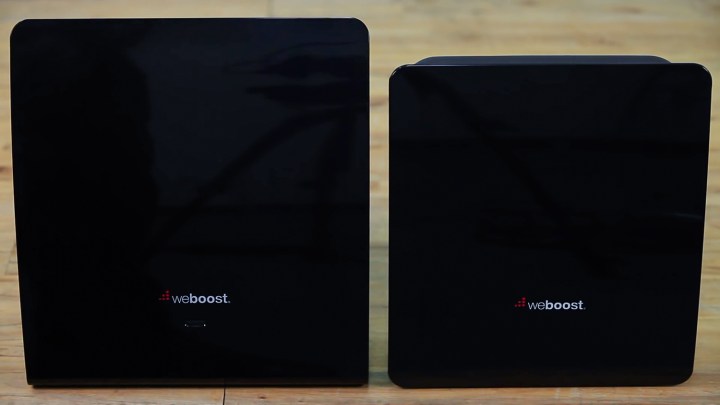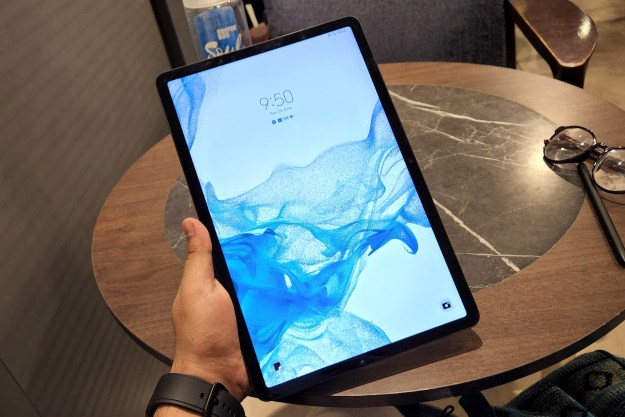
If you need the potency of 10 – 30x your normal cell phone reception, the WeBoost Eqo will do the trick.
Unfortunately, the setup for products like Eqo was once a lot more demanding than it is now. Installing a booster would mean hopping up to the roof and connecting a booster down to an amplifier with a separate antenna positioned 20 feet away. And if you weren’t capable or daring enough to endure that task, you had to hire a professional to do it for you, in which case you would be shelling out more than $400 for the booster itself plus the cost of maintenance.
In the age of the smartphone, however, things are obviously different. Not only is cell phone coverage widespread enough to nearly deem a product like the Eqo completely unnecessary, but in some instances, you could just as easily get away with using a $40 Reach Antenna case from Best Buy.
But what if your signal is so faint that a 150 percent signal boost isn’t enough? What if you need “up to 32x” the mobile reception? In this case, you might opt for something like the WeBoost Eqo, which claims to be discrete, compatible, and powerful enough to be worthy of your attention. Whether or not that’s truly the case would be determined in our own tests, conducted in a household located in a suburban neighborhood in an ordinary town with weak cell phone service.
An effortless preparation
The configuration process for the WeBoost Eqo was surprisingly as painless as the words on the box suggested. For some context, the kit comes with two main pieces: the antenna and the booster. The install guide notes that the antenna should be positioned where the signal needs boosting, while the booster itself should be placed six feet away, in the area with the best signal.
Because the diagram in the manual showed the antenna on an elevated surface, I chose to put mine on an end table located next to the couch, but wherever you plan on using your phone should suffice. Join the two units with a coaxial cable, plug the power connector from the booster to the wall, and you’re done.

Of course, you’ll need a surge protected power strip of at least 1000 Joules in order to use the booster, as indicated in Step 5 of the install guide, which is an oddly specific request that you’ll rarely encounter with other devices. Our concern was that this might alienate people who may not be as familiar with the Joule rating of their AC power strips as WeBoost would expect.
Our contact at WeBoost assured us, however, that “Most computer and electronics recommend higher joule ratings to protect the equipment of sensitive electronics, so I imagine many consumers already have one, too.”
On the plus side, there’s no need to hire anyone to get on the roof and set it up for you. This entire process took us no more than 10 minutes, but I was also taking notes as we went along. You could probably set it up in 60 seconds if you were so inclined, but we took our time carefully reading the instructions to ensure the accuracy of our field testing.
The setup itself isn’t pretty. Sure, it’s not as bad as some of the other signal boosters on the market, but it’s still far from attractive or subtle. For whatever reason, a lot of the other brands opt for glossy chromatic designs that we can’t imagine would complement any living room decor.
WeBoost’s cell signal boosters, on the other hand, adopt a style akin to a wireless network router. It’s no doubt a safe call, but the Eqo most likely won’t be hidden under your computer desk along with the immeasurable heap of wires and cables that unflatteringly decorate your office space. No, the Eqo is propped up in the living room right now, and although it most certainly makes phone calls more reliable, as my girlfriend would eagerly denounce, “It’s ugly and I hate it.”
As much as WeBoost’s Eqo booster wants to be discrete, it’s still an appalling black brick of a box that doesn’t blend in with the living room furniture.
Testing the field
The field testing aspect is where we can get a little more objective about our stance on the WeBoost Eqo; it’s also where we ran into the most trouble. Because although we did exactly as we were instructed to achieve the exact decibel rating of our signal, we weren’t noticing that dramatic of a change. A PR rep from WeBoost told us that toggling airplane mode on and off would solve this problem once and for all, and he was right.
So we had to start recollecting data. Typically, with T-Mobile, we experiencing between two to four bars in my house, so we placed the booster in an area where we get four bars. It should be noted that the WeBoost Eqo claims to be compatible with all the major carriers including T-Mobile, Verizon, AT&T, and Sprint.
In a field test, however, a bar rating matters very little.
Signal strength is logarithmic
| dBm increase | Signal power increase |
| 10 | 10X |
| 20 | 100X |
| 30 | 1,000X |
| 40 | 10,000X |
| 50 | 100,000X |
| 60 | 1,000,000X |
According to the WeBoost field testing website, “Viewing your phone’s actual signal strength reading is preferable to relying on the ‘bars’ graphic as an indication of signal strength. The issue with the bars representation is that there are no standards. My phone’s 3 bars may well represent a stronger signal than your phone’s 4 bars or even 5 bars.”
Thus, a proper field test was required to amass a more comprehensive collection of data. Using my iPhone 6S, while in motion about 25 feet from the booster, our rating started at -109dB with the WeBoost powered off, switching to -102dB with it powered on. A table given to us by the company indicates that this is less than 10x the original signal, which doesn’t make much of a case for the “up to 32x better” claim, but then again, our signal wasn’t all that shoddy to begin with.
Moving closer to the antenna, in a stationary position, our signal started at -105dB and went up to -92dB with the booster powered on. Taking into account the relationship between decibel increase and signal strength, a 13dB bump signifies a 30x increase, bringing it nearly up to par with what the company advertises. The “32x better cellular coverage” isn’t a pipe dream after all. It was nearly a reality.
Ugly, but (sometimes) necessary
Here’s the deal with signal boosters as it stands today. When they’re attractive, they’re not effective; and when they’re effective, they’re not attractive. For those who have decent service already, it’s probably not worth it. However, for anyone who lives in an area where the cell service is so bad inside their home that they have to leave the house to get a signal, the Eqo booster would be a godsend. It may not match your decor, but it will certainly improve your cell signal significantly.
For $350, the asking price is steep, but not quite as steep as some of the even less comely alternatives. If you need the potency of 10 – 30x your normal cell phone reception, the WeBoost Eqo will do the trick. Otherwise, you’re better off opting for something more affordable and less unattractive.
Buy on AmazonHighs
- Boost cell signal significantly
- Easy to set up and install
Lows
- Ugly design sticks out
- Expensive


